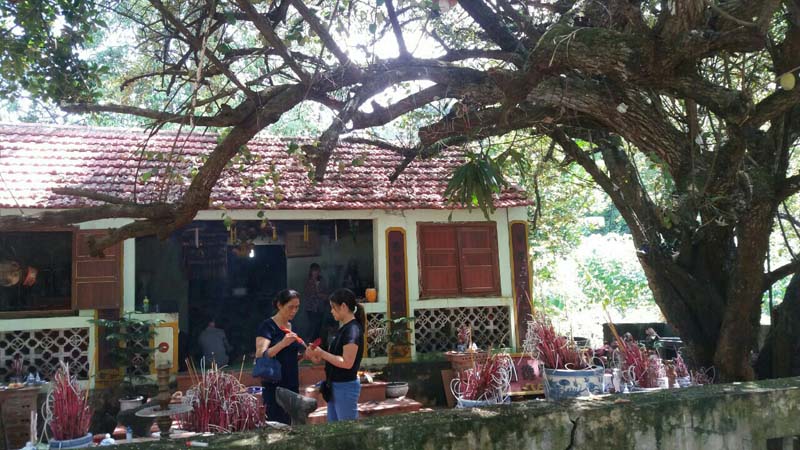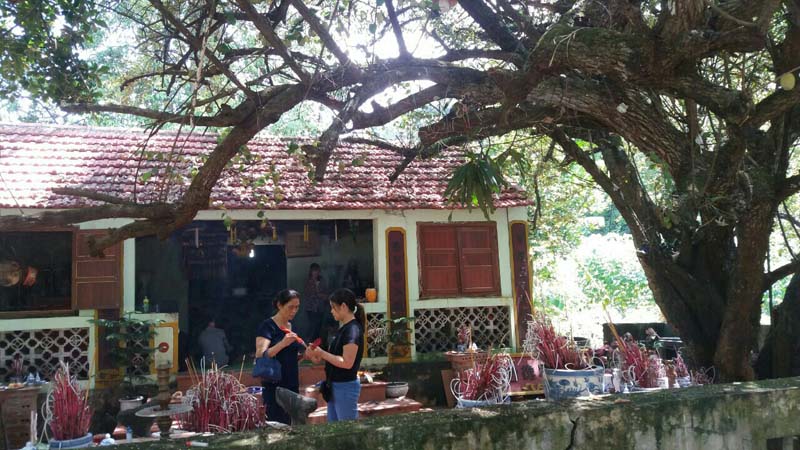
(HBO) - On a sunny Autumn day, we made out way to Tac Duc pagoda which has been popular for years. Over 5km from the centre of Lac Thinh commune, Yen Thuy district, Tac Duc pagoda sits on the foot of Kha mountain. With three compartments and a tiled roof, the pagoda is surrounded by high hills and mountains. In particular, in front of the pagoda is an ancient apple tree aging hundreds of years. Next to it is an altar dedicated to the Goddess Mother while a cool stream behind runs down from the mountain all year round.

Tac Duc pagoda
attracts visitors for incense offering, sightseeing.
According to local elderly, the pagoda was built
a long time ago with an aim of using Buddhist teachings to promote goodness, eliminate
evils and spread human kindness. Due to wear and tear over the time, the ancient
pagoda was damaged. Till the middle of the 20th century, the pagoda
was rebuilt with ironwood. The column feet were buried underground like those
of Muong ethnic people’s stilt houses. They are surrounded with planks and floored
with clay. Inside the pagoda is an altar sitting on rock pillars with other
object of worshiping.
In 2016, Tac Duc pagoda was recognised as a local
cultural and historical relic. It made active contributions to fostering
neighborliness among communes and enriching local spiritual lives. During the
anniversaries like Buddha’s birth and lunar New Year, the pagoda becomes a rendezvous
of many Buddhist followers and visitors who come to pray for peace and well-being.
The relic is an invaluable site for education about national traditions.
With convenient transportation and well-known
relics in Yen Thuy district such as Chua cave, Hang pagoda, Xam temple, Nuoc
and Thien Ton caves, and ecological tours of Muong hamlet, Thau village in Lac
Sy commune, Tac Duc pagoda has attracted numerous tourists inside and outside
the province./.
With an increasingly vibrant and widespread emulation movement aimed at building cultured residential areas and cultured families, Yen Thuy District has been making steady progress toward improving both the material and spiritual well-being of its people, while fostering a civilized, prosperous, beautiful, and progressive community.
Once lacking recreational spaces and community facilities, Residential Group 2 in Quynh Lam Ward (Hoa Binh City) has recently received attention for the construction of a new, spacious, and fully equipped cultural house. The project followed the model of state support combined with public contributions in both labor and funding.
The "All people unite to build cultural life" movement, which has been effectively integrated with Kim Boi district’s socio-economic development goals, is fostering a lively spirit of emulation across local residential areas, hamlets, villages, public agencies, and enterprises. In addition, through the initiative, traditional cultural values are being preserved and promoted, while community solidarity and mutual support in poverty reduction and economic development are being strengthened.
A working delegation of the Hoa Binh provincial People’s Committee led by its Permanent Vice Chairman Nguyen Van Toan on June 11 inspected the progress of a project to build the Mo Muong Cultural Heritage Conservation Space linked to tourism services in Hop Phong commune, Cao Phong district.
Born and growing in the heroic land of Muong Dong, Dinh Thi Kieu Dung, a resident in Bo town of Kim Boi district, in her childhood was nurtured by the sweet lullabies of her grandmother and mother. These melodies deeply imprinted on her soul, becoming an inseparable part of her love for her ethnic group's culture. For over 20 years, this love for her hometown has driven Dung to research, collect, and pass down the cultural values of the Muong people to future generations.
In the final days of May, the Ethnic Art Troupe of Hoa Binh Province organized performances to serve the people in remote, mountainous, and particularly disadvantaged areas within the province. These were not just ordinary artistic shows, but they were the meaningful journeys aimed at spreading cultural values, enhancing the spiritual life of the people and contributing to the preservation of ethnic minority cultural identities.



